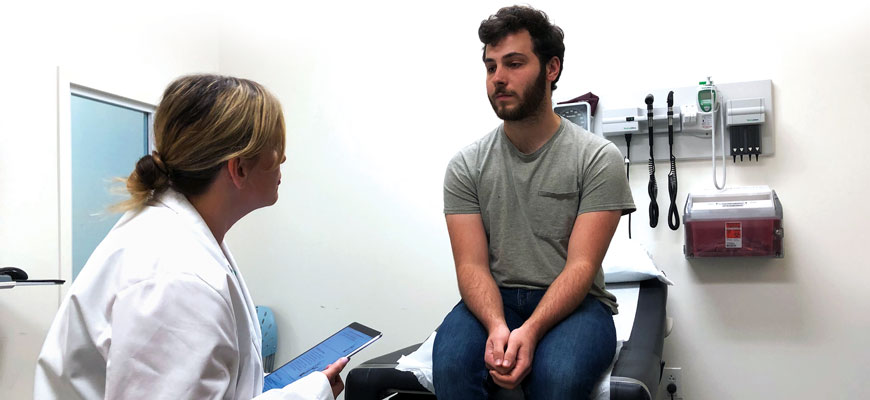
Researchers use virtual reality videos to help medical students cultivate compassion
Posted on: October 7, 2019; Updated on: October 7, 2019
By Chris Horn, chorn@mailbox.sc.edu, 803-777-3687
Medical students usually begin their education with a big dose of altruism, but their empathy for patients often fades before they’ve even completed their degrees.
That’s significant because gaining insight into a patient’s concerns and feelings is essential for positive clinical interactions between patients and physicians and better health outcomes. A remedy for decreased empathy might come in the form of virtual reality videos that researchers at the University of South Carolina School of Medicine Greenville are testing this fall. The project is funded by the university’s Center for Teaching Excellence and Prisma Health.
“We’re trying to get our students to understand the need to dig a little deeper when talking to patients — to try to put themselves in their patients’ shoes,” says Ann Blair Kennedy, director of the Patient Engagement Studio and clinical assistant professor. “Empathy can be taught, and an effective technique for teaching it is perspective-taking, where individuals are invited to take the perspective of the patient.”
We’re trying to figure out if the virtual reality videos are effective in improving student empathy and, if so, how they might be used more extensively in the classroom.
Ann Blair Kennedy, director of the Patient Engagement Studio and clinical assistant professor
To that end, a group of 50 first- and second-year students will be assigned to watch virtual reality videos featuring six-minute segments that depict a typical patient/physician visit. In the first video, the viewer watches actors posing as physician and patient as they converse. The second video is seen from the patient’s point of view only. As the doctor talks with the patient, the patient’s thoughts appear in print in the margin of the video.
“It becomes apparent that the doctor doesn’t probe deeply enough with the patient,” says Shannon Stark Taylor, a psychologist at Prisma Health Upstate and clinical assistant professor. “There is something that the provider likely missed and the patient is having a really emotional reaction because the physician didn’t ask in the right way or follow up with more questions.”
As students watch the videos, monitors will gather biofeedback data such as heart rate variability, which is a physiological measure of empathy. That data will be part of the pre- and post-assessment of students to measure the videos’ effectiveness.
A second randomized group of students will watch PowerPoint videos of similar length that contain standard lecture material on empathizing with patients.
“We’re trying to figure out if the virtual reality videos are effective in improving student empathy and, if so, how they might be used more extensively in the classroom,” Kennedy says.
Results of the study will be tabulated in the spring. Lauren Fowler, a clinical assistant professor, is a co-investigator on the project, and four students (two of them second-year medical students) have shot and edited the video and will assist in the study’s implementation.
Share this Story! Let friends in your social network know what you are reading about